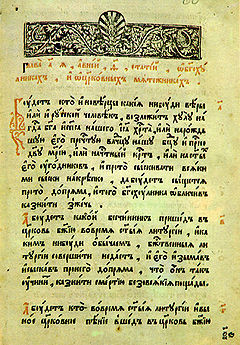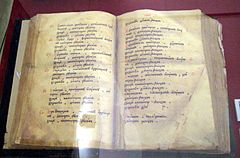- Sobornoye Ulozheniye
-
The Sobornoye Ulozheniye (Russian: Соборное уложение) was a legal code promulgated in 1649 by the Zemsky Sobor under Alexis of Russia as a replacement for the Sudebnik of 1497 introduced by Ivan III of Russia, which is based, among others, on the Third Statute of Lithuania. The code survived well into the 19th century (up to 1849), when its articles were revised under the direction of Mikhail Speransky.
The code consolidated Russia's slaves and free peasants into a new serf class and pronounced that class hereditary and unchangeable (see Russian serfdom). Travel between towns was made forbidden without an internal passport. Russian nobility agreed to serve in the army, but were granted the exclusive privilege of owning serfs.
Contents
The causes of promulgation
As the Time of Troubles ended, a new dynastic government (Romanovs) commenced active law-making. An intensive growth of the number of edicts ("ukases") since the Sudebnik of 1497 can be seen from the following data:
Years edicts 1550–1600 80 1601–1610 17 1611–1620 97 1621–1630 90 1631–1640 98 1641–1648 63 Overall, in the years 1611-1648, a total of 348 edicts were issued, and in the period of 1550-1648, another 445 edicts. This led to a situation in a Russian state when there existed an immense number of state edicts, which not only were obsolete, but even contradicted each other.
This chaos was contributed to by the scattering of normative acts throughout different state institutes (traditionally new edicts were made on demand of some prikaz, and after their promulgation were attached to an edict book of this prikaz). There was also an absence of coordination in law application: a new article in this book was often known only to the statesmen of the given prikaz. Also, the casual character of legal rules was becoming inefficient. The legislators now sought to regulate legal rules, that is, to pass on to a normative interpretation of legal rules.
The Salt Riot, which broke out in Moscow in 1648, also contributed to the promulgation of the Sobornoye Ulozheniye, one of the demands of the rioters being to call the Zemsky Sobor and to make a new legal code. The riot was suppressed, but as one of the concessions to the rioters, the czar called the Zemsky Sobor, which continued to work until the promulgation of Sobornoye Ulozheniye in 1649.
Lawmaking
A special committee headed by Prince Nikita Odoevskiy (Н. И. Одоевский) was created to make bill of Ulozhenie. Other members of that committee are: Prince Prozorov S. V. (С. В. Прозоров), Okolnichy Prince (one of highest ranks of boyars in old Russia), Volkonskiy F. F. (Ф. Ф. Волконский), scribe Gavrila Leontev (Г. Леонтьев) and scribe Fedor Griboedov (Ф. Грибоедов). At that time, practical job of Zemsky Sobor had been started.
Zemsky Sobor was intended to consider a bill of Ulozhenie. Many members, include representatives of posad people (ru:Посадские люди) communities. Zemsky Sobor consisted of two houses. At one of them Tsar, Boyar Duma and Consecrated Sobor (Освященный собор). Elected people of different ranks took part in sessions of another house.
Deputies of Nobility and posad people had a big impact to adoption of many norms of Ulozhenie. At 29-th of January, 1649 making and editing of Ulozhenie had been ended. Original of this historical document is scroll consist of 959 narrow columns. At the end of it, Ulozhenie had been signed by 315 signatures of Sobor members. Signatures of scribes located at splicings of columns. Centuries later, at the times of Catherine II reign a silver ark had been made for storage of this original scroll. At the present time, original of Sobornoye Ulozheniye is kept in Kremlin Armoury.
Then a copy of scroll had been written in book format. From this book, Ulozhenie had been printed twice (1200 copies each time) during year 1649. Sobornoye Ulozheniye 1649 was a new stage in the development of Russian legal technicality.
All Sobor members had also signed handwritten copies of Ulozhenie which had been sent to all state offices (prikazes) in Moscow as blueprint for action.
Elected people inserted own amendment and additions to Duma as petitions of Zemstvo. Some decision were being made by elected, Duma and Tsar together.
Vasily Klyuchevsky singles out several technical stages at process of lawmaking of Ulozhenie:
- Codification — work with sources, editing) by committee headed by Prince Odoevskiy.
- Conference — bringing up petition for discussion.
- Revision — revision and edition bills by Duma and Tsar.
- Legislative decision — a common decision about one or another article of Ulozhenie.
- Hand signing (Russian: Заручная скрепа) — signing of code of laws by all without any exception members of Sobor.
First time legislator tried to form system of norms and classify it by the areas of law.
Great attention had been given to procedural law.
Sources of Ulozhenie
Sources of Sobornoe Ulozhenie was as Russian as international law.
- Prikazes' book of orders (Russian: Указные книги приказов) - from time of appearing of some Prikaz, current law in concrete area of law were being fixed in it.
- Sudebnik of 1497 and Sudebnik by Ivan IV.
- Statutes of Lithuania (1588) had been used as model (pattern) of legal technicality
- Petitions (Russian: Челобитные (Chelobitnye))
External links
Categories:- Legal codes
- Politics of Muscovy
- 1649 establishments
- Legal history of Russia
Wikimedia Foundation. 2010.


